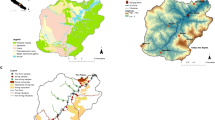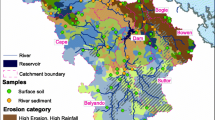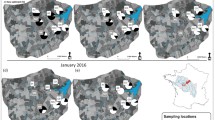Abstract
Purpose
Land use change and the associated acceleration of soil erosion have increased sediment supply to rivers worldwide. To effectively manage sediment loads, it is important to understand sediment dynamics. Fallout radionuclides (i.e. Be-7, excess Pb-210, Cs-137) separately provide spatial and temporal sediment source information. However, their combined application has been limited by an assumption that subsurface sources do not receive 7Be fallout. Here, we examine this assumption and investigate the utility of combining these radionuclides to simultaneously model spatial and temporal sediment source dynamics.
Materials and methods
Soil and subsurface material were sampled to characterize potential sediment sources in a 12-km2 catchment in northern Laos. This included material that was directly sampled from surface and subsurface sources (n = 65) and also in situ sediment source samples that were collected in ephemeral flow on hillslopes (n = 19). Suspended sediment (n = 16) was sampled at two monitoring stations. A distribution modelling approach quantified the relative contributions of surface and subsurface sources, as well as the proportion of material labelled with 7Be. The results from these two end-member models were compared to a four end-member model examining contributions from recently eroded surface, recently eroded subsurface, re-suspended surface and re-suspended subsurface sources.
Results and discussion
Approximately 80 % of sediment was modelled to be supplied by sources labelled with 7Be. Subsurface sources were modelled to contribute ~75 % of sediment. Accordingly, there was ~55 % more sediment modelled from subsurface sources than expected if subsurface sources were sheltered from 7Be fallout. Differences between subsoil and 7Be-labelled source contributions modelled by the two and four end-member models were, with one exception (0.3 %), within the range of model uncertainty, further supporting the existence of re-suspended subsurface sources. At an upstream sampling location (S4), surface sources contributed the majority of sediment (55 %) whereas subsurface sources dominated the supply of sediment downstream (S10—74 %). Importantly, re-suspended subsurface sources, labelled with 7Be, were a significant sediment source at the catchment outlet (S10—60 %) during the investigated event.
Conclusions and perspectives
This study demonstrates the utility of combining multiple radionuclides when investigating spatial and temporal sediment source dynamics in tropical, ephemeral catchments. In the future, this approach should be tested with larger source datasets during the entire wet season and in larger catchments. This research furthers our understanding of sediment propagation in tropical catchments, contributing to the implementation of efficient soil conservation measures to reduce the deleterious effects of suspended sediment loads.






Similar content being viewed by others
References
Belmont P, Gran KB, Schottler SP, Wilcock PR, Day SS, Jennings C, Lauer JW, Viparelli E, Willenbring JK, Engstrom DR, Parker G (2011) Large shift in source of fine sediment in the upper Mississippi river. Environ Sci Technol 45:8804–8810
Belmont P, Willenbring JK, Schottler SP, Marquard J, Kumarasamy K, Hemmis JM (2014) Toward generalizable sediment fingerprinting with tracers that are conservative and nonconservative over sediment routing timescales. J Soils Sediments 14:1479–1492
Ben Slimane A, Raclot D, Evrard O, Sanaa M, Lefèvre I, Ahmadi M, Tounsi M, Rumpel C, Ben Mammou A, Le Bissonnais Y (2013) Fingerprinting sediment sources in the outlet reservoir of a hilly cultivated catchment in Tunisia. J Soils Sediments 13:801–815
Bonniwell EC, Matisoff G, Whiting PJ (1999) Determining the times and distances of particle transit in a mountain stream using fallout radionuclides. Geomorphol 27:75–92
Caitcheon G, Olley J, Pantus F, Hancock GR, Leslie C (2012) The dominant erosion processes supplying fine sediment to three major rivers in tropical Australia, the Daly (NT), Mitchell (Qld) and Cloncurry (Qld) Rivers. Geomorphol 151–152:188–195
Chaplot V, Podwojewski P, Phachomphon K, Valentin C (2009) Soil erosion impact on soil organic carbon spatial variability on steep tropical slopes. Soil Sci Soc Am J 73(3):769–779
Chartin C, Evrard O, Onda Y, Patin J, Lefèvre I, Ottlé C, Ayrault S, Lepage H, Bonté P (2013) Tracking the early dispersion of contaminated sediment along rivers draining the Fukushima radioactive pollution plume. Anthropocene 1:23–34
Collins AL, Walling DE, Leeks GJL (1997) Source type ascription for fluvial suspended sediment based on a quantitative composite fingerprinting technique. Catena 29:1–27
Collins AL, Naden PS, Sear DA, Jones JI, Foster IDL, Morrow K (2011) Sediment targets for informing river catchment management: international experience and prospects. Hydrol Process 25:2112–2129
Duvert C, Gratiot N, Evrard O, Navratil O, Némery J, Prat C, Esteves M (2010) Drivers of erosion and suspended sediment transport in three headwater catchments of the Mexican Central Highlands. Geomorphol 123:243–256
Evrard O, Némery J, Gratiot N, Duvert C, Ayrault S, Lefèvre I, Poulenard J, Prat C, Bonté P, Esteves M (2010) Sediment dynamics during the rainy season in tropical highland catchments of central Mexico using fallout radionuclides. Geomorphol 124:42–54
Evrard O, Poulenard J, Nemery J, Ayrault S, Gratiot N, Duvert C, Prat C, Lefèvre I, Bonté P, Esteves M (2013) Tracing sediment sources in a tropical highland catchment of central Mexico by using conventional and alternative fingerprinting methods. Hydrol Process 27:911–922
Falbo K, Schneider RL, Buckley DH, Walter MT, Bergholz PW, Buchanan BP (2013) Roadside ditches as conduits of fecal indicator organisms and sediment: implications for water quality management. J Environ Manag 128:1050–1059
Gateuille D, Evrard O, Lefevre I, Moreau-Guigon E, Alliot F, Chevreuil M, Mouchel JM (2014) Mass balance and decontamination times of polycyclic aromatic hydrocarbons in rural nested catchments of an early industrialized region (Seine River basin, France). Sci Total Environ 470–471:608–617
Gourdin E (2014) Traçage des sources et quantification de la dynamique des sédiments en crue: application au bassin tropical montagneux de la Houay Xon au Laos. PhD thesis, Université Paris Sud-Paris XI, Paris, France
Gourdin E, Evrard O, Huon S, Lefèvre I, Ribolzi O, Reyss J-L, Sengtaheuanghoung O, Ayrault S (2014a) Suspended sediment dynamics in a Southeast Asian mountainous catchment: combining river monitoring and fallout radionuclide tracers. J Hydrol 519:1811–1823
Gourdin E, Evrard O, Huon S, Reyss J-L, Ribolzi O, Bariac T, Sengtaheuanghoung O, Ayrault S (2014b) Spatial and temporal variability of 7Be and 210Pb wet deposition during four successive monsoon storms in a catchment of northern Laos. J Environ Radioact 136:195–205
Haddadchi A, Ryder DS, Evrard O, Olley J (2013) Sediment fingerprinting in fluvial systems: review of tracers, sediment sources and mixing models. Int J Sed Res 28:560–578
Hancock GJ, Wilkinson SN, Hawdon AA, Keen RJ (2014) Use of fallout tracers 7Be, 210Pb and 137Cs to distinguish the form of sub-surface soil erosion delivering sediment to rivers in large catchments. Hydrol Process 28:3855–3874
Huisman NLH, Karthikeyan KG, Lamba J, Thompson AM, Peaslee G (2013) Quantification of seasonal sediment and phosphorus transport dynamics in an agricultural watershed using radiometric fingerprinting techniques. J Soils Sediments 13:1724–1734
Huon S, de Rouw A, Bonté P, Robain H, Valentin C, Lefèvre I, Girardin C, Le Troquer Y, Podwojewski P, Sengtaheuanghoung O (2013) Long-term soil carbon loss and accumulation in a catchment following the conversion of forest to arable land in northern Laos. Agr Ecosyst Environ 169:43–57
Koiter AJ, Owens PN, Petticrew EL, Lobb DA (2013) The behavioural characteristics of sediment properties and their implications for sediment fingerprinting as an approach for identifying sediment sources in river basins. Earth-Sci Rev 125:24–42
Laceby JP, Olley J (2015) An examination of geochemical modelling approaches to tracing sediment sources incorporating distribution mixing and elemental correlations. Hydrol Process 29:1669–1685
Laceby JP, McMahon J, Evrard O, Olley J (2015) A comparison of geological and statistical approaches to element selection for sediment fingerprinting. J Soils Sediments 15:2117–2131
Le Cloarec MF, Bonte P, Lefevre I, Mouchel JM, Colbert S (2007) Distribution of 7Be, 210Pb and 137Cs in watersheds of different scales in the Seine River basin: inventories and residence times. Sci Total Environ 375:125–139
Mabit L, Benmansour M, Walling DE (2008) Comparative advantages and limitations of the fallout radionuclides 137Cs, 210Pbex and 7Be for assessing soil erosion and sedimentation. J Environ Radioact 99:1799–1807
Matisoff G, Wilson CG, Whiting PJ (2005) The 7Be/210Pbxs ratio as an indicator of suspended sediment age or fraction new sediment in suspension. Earth Surf Process Landf 30:1191–1201
Olley J, Caitcheon G (2000) Major element chemistry of sediments from the Darling-Barwon river and its tributaries: implications for sediment and phosphorus sources. Hydrol Process 14:1159–1175
Olley J, Brooks A, Spencer J, Pietsch T, Borombovits D (2013) Subsoil erosion dominates the supply of fine sediment to rivers draining into Princess Charlotte Bay, Australia. J Environ Radioact 124:121–129
Oracle (2013) Crystal Ball (Version: 11.2.3.500, 32 Bit, Classroom Edition)
Owens PN, Batalla RJ, Collins AJ, Gomez B, Hicks DM, Horowitz AJ, Kondolf GM, Marden M, Page MJ, Peacock DH, Petticrew EL, Salomons W, Trustrum NA (2005) Fine-grained sediment in river systems: environmental significance and management issues. River Res Appl 21:693–717
Ribolzi O, Cuny J, Sengsoulichanh P, Pierret A, Pierre Thiebaux J, Huon S, Bourdon E, Robain H, Sengtaheuangoung O (2008) Assessment of water quality along a tributary of the Mekong river in a mountainous, mixed land use environment of the Lao P.D.R. Lao Journal of Agriculture and Forestry, 2008(MSEC Management of Soil Erosion Consortium special), pp 91–111
Ribolzi O, Cuny J, Sengsoulichanh P, Mousques C, Soulileuth B, Pierret A, Huon S, Sengtaheuanghoung O (2011) Land use and water quality along a Mekong tributary in northern Lao P.D.R. Environ Manag 47:291–302
Smith HG, Blake WH (2014) Sediment fingerprinting in agricultural catchments: a critical re-examination of source discrimination and data corrections. Geomorphol 204:177–191
Smith HG, Sheridan GJ, Nyman P, Child DP, Lane PNJ, Hotchkis MAC, Jacobsen GE (2012) Quantifying sources of fine sediment supplied to post-fire debris flows using fallout radionuclide tracers. Geomorphol 139–140:403–415
Taylor A, Blake WH, Couldrick L, Keith-Roach MJ (2012) Sorption behaviour of beryllium-7 and implications for its use as a sediment tracer. Geoderma 187–188:16–23
Taylor A, Blake WH, Smith HG, Mabit L, Keith-Roach MJ (2013) Assumptions and challenges in the use of fallout beryllium-7 as a soil and sediment tracer in river basins. Earth-Sci Rev 126:85–95
Theuring P, Rode M, Behrens S, Kirchner G, Jha A (2013) Identification of fluvial sediment sources in the Kharaa River catchment, Northern Mongolia. Hydrol Process 27:845–856
Turner JN, Brewer PA, Macklin MG (2008) Fluvial-controlled metal and As mobilisation, dispersal and storage in the Rio Guadiamar, SW Spain and its implications for long-term contaminant fluxes to the Donana wetlands. Sci Total Environ 394:144–161
Valentin C, Agus F, Alamban R, Boosaner A, Bricquet JP, Chaplot V, de Guzman T, de Rouw A, Janeau JL, Orange D, Phachomphonh K, Do Duy P, Podwojewski P, Ribolzi O, Silvera N, Subagyono K, Thiébaux JP, Tran Duc T, Vadari T (2008) Runoff and sediment losses from 27 upland catchments in Southeast Asia: impact of rapid land use changes and conservation practices. Agr Ecosyst Environ 128:225–238
Wallbrink PJ, Murray AS (1996) Determining soil loss using the inventory ratio of excess-lead 210 to cesium-137. Soil Sci Soc Am J 60:1201–1208
Walling DE (2005) Tracing suspended sediment sources in catchments and river systems. Sci Total Environ 344:159–184
Walling DE (2013) Beryllium-7: the Cinderella of fallout radionuclide sediment tracers? Hydrol Process 27:830–844
Wilkinson SN, Prosser IP, Rustomji P, Read AM (2009) Modelling and testing spatially distributed sediment budgets to relate erosion processes to sediment yields. Environ Model Softw 24:489–501
Wilkinson S, Olley J, Furuichi T, Burton J, Kinsey-Henderson A (2015) Sediment source tracing with stratified sampling and weightings based on spatial gradients in soil erosion. J Soils Sediments 15:2038–2051
Acknowledgments
The authors would like to thank the Lao Department of Agriculture Land Management (DALam) and the Multi-Scale Environment Changes (MSEC) project for their support. They are also grateful to Keo Oudone Latsachack, Bounsamai Soulileuth, Chanthamousone Thammahacksa and Elian Gourdin for their help during fieldwork and labwork. This work received financial support from the French Centre National de la Recherche Scientifique EC2CO/BIOHEFECT programme (Belcrue and Belkong projects) as well as from the French National Research Agency (TecItEasy project; ANR-13-AGRO-0007). Finally, the authors would like to thank the anonymous reviewers for their constructive comments and feedback.
Author information
Authors and Affiliations
Corresponding author
Additional information
Responsible editor: William H. Blake
Electronic supplementary material
Below is the link to the electronic supplementary material.
ESM 1
(DOCX 39 kb)
Rights and permissions
About this article
Cite this article
Evrard, O., Laceby, J.P., Huon, S. et al. Combining multiple fallout radionuclides (137Cs, 7Be, 210Pbxs) to investigate temporal sediment source dynamics in tropical, ephemeral riverine systems. J Soils Sediments 16, 1130–1144 (2016). https://doi.org/10.1007/s11368-015-1316-y
Received:
Accepted:
Published:
Issue Date:
DOI: https://doi.org/10.1007/s11368-015-1316-y




